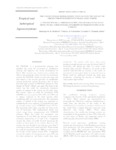Please use this identifier to cite or link to this item:
http://www.alice.cnptia.embrapa.br/alice/handle/doc/534496| Title: | The use of linear programming to evaluate the impact of credit for investments in small goat farms. |
| Authors: | MEDEIROS, H. R. de  GUIMARÃES, V. P.   HOLANDA JUNIOR, E. V.   |
| Affiliation: | Henrique Rocha de Medeiros, Bolsista FUNCAP / CNPq / Embrapa Caprinos; Vinícius Pereira Guimarães, Consultor DCR Funcap/Embrapa Caprinos; EVANDRO VASCONCELOS HOLANDA JUNIOR, CNPC. |
| Date Issued: | 2009 |
| Citation: | Tropical and Subtropical Agroecosystems, v. 11, n. 9, p. 7-11, 2009. |
| Description: | Abstract: The PRONAF is a governmental program that subsidies the credit for investment to smallholder farming and improves the social development in Brazil. This research was carried out to evaluate the effect of increasing the values of credit for investment used for the PRONAF farmers in semi-arid areas, and their impact in the income and labor in smallholder farming production system. Economic data of dairy and meat goat systems of PRONAF farmers in ?Rio Grande do Norte?, Brazil was used. The limit of the model was the credit for investment, maximum number of animals in the system and the labor time. The current values of credit for investment (US$ 2,850.00) were increased by 25%, 50% and 100% and its impact analyzed in the farm income when considering milk and meat production. The maximum number of animals in the system was estimated by multiplying the carry capacity (1.5 heads/ha/year) plus the average pasture areas of PRONAF farms (35 ha). The maximum labor time, available for farm work, was 12 hours/day. This mathematical model was solved using linear programming with LINDO® software. When the credit for investment was expanded in 25 and 50%, the income of the system increased, respectively, to 22 and 41%. It happened because the values of credit allowed increasing the number of dairy goats in the system. However, this income was not enough to use and pay more than 5 hours/day in dairy goat system activities. When raising the credit for investment up to 100% it could increase the income of the system around 81%. It happened because the number of dairy goats grew up to 83% and the dairy production had better results than meat production. The system with more dairy goats produces enough income as to pay the farmer labor (7 hours/day) and during the other five hours could develop other activities. Therefore, the results of the analysis indicated that an increase in the credit for investment in small goat farms in semi-arid areas in Brazil could be addressed towards the dairy goat production, enhancing the income of families and employment opportunities. |
| Thesagro: | Caprino Pequeno produtor Agricultura familiar Custo de Produção Financiamento Crédito rural Investimento Desenvolvimento rural Sistema de produção Modelo de Simulação |
| NAL Thesaurus: | Goats Farm Credit System Farm planning Rural development Animal models Brazil |
| Keywords: | Modelagem Modeling Pronaf Brasil Região Nordeste Family farming Production systems Smallholders |
| Notes: | Edição de proceedings 9th International Goat Conference; 23th Conference ofthe Asociación Mexicana de Producción Caprinaat Queretaro, Mexico, in September 2008. XXIII Conference ofthe Asociación Mexicana de Producción Caprina |
| Type of Material: | Artigo em anais e proceedings |
| Access: | openAccess |
| Appears in Collections: | Artigo em anais de congresso (CNPC)  |
Files in This Item:
| File | Description | Size | Format | |
|---|---|---|---|---|
| NTTheuseoflinearprogramming.pdf | 101.49 kB | Adobe PDF |  View/Open |









